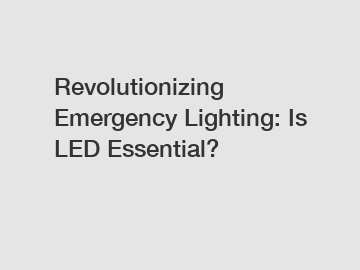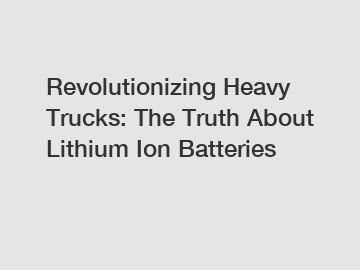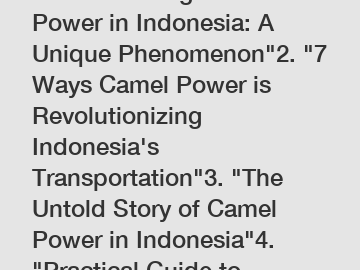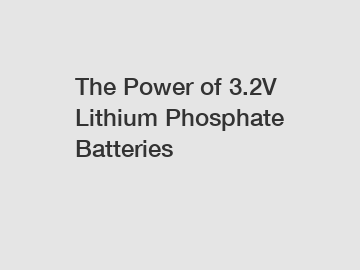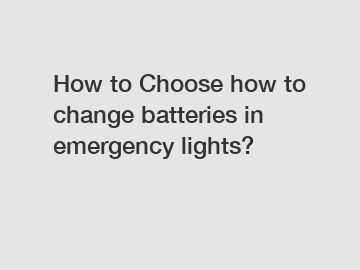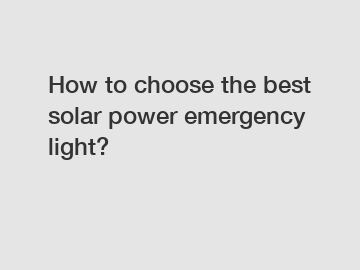What Are the Advantages and Disadvantages of LiFePO4 ...
What Are the Advantages and Disadvantages of LiFePO4 ...
''LiFePO4 batteries, also known as lithium iron phosphate batteries, have gained popularity in various applications due to their unique characteristics. In this article, we will explore the advantages and disadvantages of LiFePO4 batteries, helping you understand their strengths and limitations.
Goto Lithium Storage to know more.
'Advantages of
lifepo4 lithium batteri
es''1. Safety: LiFePO4 batteries are considered one of the safest lithium-ion battery chemistries available. They have a stable chemical structure that is less prone to thermal runaway or combustion, making them a reliable choice for applications where safety is crucial.
''2. Long Cycle Life: LiFePO4 batteries have an impressive cycle life, capable of enduring thousands of charge-discharge cycles without significant capacity loss. This makes them ideal for applications that require frequent cycling, such as electric vehicles and renewable energy storage systems.
''3. High Power Density: LiFePO4 batteries can deliver high power output, making them suitable for applications that require bursts of energy or high power demands. They can handle rapid charging and discharging without compromising their performance or longevity.
''4. Wide Temperature Range: lifepo4 lithium battery can operate effectively in a wide temperature range, from extreme cold to high heat. This versatility makes them suitable for use in various environments and climates.
''5. Environmental Friendliness: lifepo4 lithium batteries are considered more environmentally friendly compared to other lithium-ion chemistries. They do not contain toxic heavy metals like cobalt, which can be harmful to the environment during production and disposal.
'Disadvantages of lithium ion lifepo4 battery
''1. Lower Energy Density: LiFePO4 batteries have a lower energy density compared to other lithium-ion chemistries. This means they have a lower capacity to store energy per unit of weight or volume. As a result, LiFePO4 batteries may be bulkier and heavier for the same energy storage capacity.
''2. Higher Cost: lithium ion lifepo4 battery tend to be more expensive compared to other lithium-ion batteries. The manufacturing process and the use of high-quality materials contribute to their higher cost. However, it's important to consider their long cycle life and safety advantages when evaluating the overall cost-effectiveness.
''3. Limited Availability: While lithium ion lifepo4 batteries are becoming more widely available, their availability may still be limited compared to other lithium-ion chemistries. This can affect the ease of sourcing and the range of options available in the market.
''LiFePO4 batteries offer several advantages, including safety, long cycle life, high power density, wide temperature range, and environmental friendliness. However, they also have some disadvantages, such as lower energy density, higher cost, and limited availability. Understanding these pros and cons can help you make informed decisions when considering LiFePO4 batteries for your specific applications.
Why We're Excited about LFP Batteries for Electric Cars
An LFP battery is a type of lithium ion battery that is highly stable, has a long lifespan, and tends to be more resistant to heat degradation than their other lithium ion cousins. They are also known as lithium iron phosphate, or LiFePO4 batteries.
Lithium Cobalt Oxide. Lithium Manganese Oxide. Lithium Nickel Cobalt Aluminum Oxide.
These are just some of the various types of batteries that fall into the lithium ion family. They are generally named after the chemicals used in the cathode, which is what lithium ions flow towards when the battery is being used.
Why are there different EV battery types?
Different EV battery compositions optimize different things, such as the life span, maximum charge speed, or how much energy a cell can hold. The specific chemistry that is used depends heavily on how it is being used.
For instance, batteries with manganese have very low internal resistance and can be charged pretty fast. However, these batteries tend to have shorter lifetimes.
For EV use, the most popular batteries are NMC (lithium nickel manganese cobalt oxide) and NCA (lithium nickel cobalt aluminum oxides), which combine metals with nickel and cobalt to make them last longer and hold the most energy. However, LFP batteries, also known as lithium iron phosphate, or LiFePO4 (Li = lithium, Fe = iron, PO4 = phosphate) are the new kid on the block.
Pros and cons of LFP
Benefits of LFP Batteries
- The cost savings. LFP batteries are cheaper to produce, and that means more affordable EVs for a wider demographic of shoppers. NCA battery cells clock in at about $120.30 per kWh, NMC at about $112.70/kWh, and LFP as low as $98.50/kWh.
- Longer life. LFP batteries have a longer cycle life, meaning they can be used from full to empty (or the equivalent thereof), more times than NCA or NMC batteries. This is a part of why Tesla recommends charging your LFP battery to 100% once a week, but capping charged for nickel based batteries at 80%.
- More resistant to aging from fast charging. Although our preliminary Tesla results indicated that occasional fast charging does not have any drastic, short term effect on range, laboratory science has shown us that NCA and NMC batteries are sensitive to long term degradation from frequent high-voltage, high-heat charging. The same is not necessarily true of LFP batteries. This is because LFP batteries rely on a 3-D, crystalline structure, and can withstand high temperatures without decomposing.
- Lower fire risk. Lithium ion battery fires are usually due to extreme heat conditions, and are triggered by something called thermal runaway, which happens when the temperature of the pack exceeds a certain limit. For LFP batteries, thermal runaway temperature is at 270 degrees C, as compared to 210 C for NMC and 150 C for NCA. This makes them super safe for on-the-road uses.
- Fewer environmental and ethical issues. Because they avoid cobalt and nickel, LFP batteries can be produce, on average, 15-25% lower carbon emissions than NMCs. They also avoid some of the humanitarian criticisms about battery manufacturing, but not all. We have a deep dive on the topic here.
Nerdy Aside: Why do LFP batteries promise to be more resistant against heat-related aging and degradation? Simply put, the Fe-PO bond in LFP compositions is stronger than the Co-O bond in cobalt-based batteries, so that if abused (short-circuited, overheated, etc.) the oxygen atoms are much harder to remove. This means that under stress, a LFP battery is more likely to resist rapid rises in temperature, which can result in permanent battery damage or in dire cases - start a fire.
Downsides of LFP Batteries
While we're excited about the adoption of more LFP technology, we are scientists, and we do want to mention the compromises that come with using LFP packs.
- Lower energy density. LFP batteries give you about 30% less energy in the same sized battery. That means if you want the same range as you had in an NCA powered car, you need to add more batteries, which means more weight and hardware. For some models, this means slightly lower 0-60 acceleration, too.
- Worse performance in sub-freezing temperatures. Reviewers and testers in Canada, Norway, and other icy climates report that range loss, even with preconditioning, can be a few percentage points above what is seen with NCA Model 3s. Warming the batteries enough to fast charge may also take longer for LFPs. This poor performance comes down to poor conductivity and slow lithium-ion diffusion. In practice, this means poor charge rate when it's colder than '20'°C ('4'°F). NCM batteries perform significantly better, with increased capacity retention and polarization. However, it is possible that improved and more aggressive thermal management may be able to offset cold weather effects.
Which carmakers are adopting LFP batteries?
Tesla announced a switch to the lithium iron packs in their standard range models in . The change started in China-made Standard Range vehicles and reached the US in .
On their heels came news from Ford in that they plan to switch to LFP packs in European Mustang Mach-Es and in select F-150 markets in . These new LFP packs are already on the road in Standard Range Mach-Es in the US, but in limited numbers. Recurrent only has a handful in our fleet so far. Fisker Ocean is also using LFP packs in their base configuration, the Sport.
'Rivian announced a switch to LFP batteries and new cell configurations, allowing for faster production. They will start using LFPs in their Electric Delivery Vans for Amazon, and then switch over in their Standard Range trucks.
GM announced that its revamped Chevrolet Bolt EV would use LFP packs to help cut costs.
BMW also announced it will start using LFP batteries in .
Which EV models get LFP batteries?
Tesla announced in October that it was switching to LFP batteries for its standard range models in both Model 3 and Model Y.
See also:What is a string inverter?
Camel Online Shop
Why are NiCad rechargeable batteries the best?
How to Choose AGM vs Lithium Car Battery
Why Camel Power Indonesia is revolutionizing transportation?
Are 3.2V LiFePO4 Batteries The Future?
Are AGM batteries cheaper?
The company is the world’s best lithium ion phosphate batteries supplier. We are your one-stop shop for all needs. Our staff are highly-specialized and will help you find the product you need.
But why did it keep cobalt batteries for the Long Range trims?
Since the LFP packs have lower energy density, you need a larger LFP battery for long range or mind-boggling acceleration. The larger battery adds weight and can reduce efficiency. Because of this, most automakers are only looking to use them in Standard Range and non-performance trims.
However, we will see how Ford fares with using LFP packs in their much larger, much heavier F-150s.
What does Recurrent data show about LFP batteries in Teslas?
After some very public investigation this year, the world learned that the displayed dashboard range for most Teslas is higher than the actual, achievable range that the same cars actually get. Recurrent came up with a proprietary value, Real Range, to show the typical, achievable range we observe for an average Tesla. The chart below shows how much of the EPA range Teslas usually get, and the temperature dependence of this value.
What we see, at least for Tesla Model 3s, is two-fold:
- The peak range seems to happen at a higher temperature for LFP batteries as compared to non-LFP batteries, and
- The LFP models seem to get a higher percentage of their EPA range than the non-LFP vehicles.
Both of these results are exciting, although preliminary. They show differences in the ideal operating temperature for LFP batteries, which seem to get the highest range at around 70 degrees, compared to around 60 degrees for NCA packs.
They also show that the EPA range advertised for the Standard Range Model 3s is slightly closer to the truth than it is for the Long Range and Performance models. It's important for Tesla drivers to know what their actual, achievable range is in the real world, in order to understand the limits and possibilities of their car. Of course, as we like to say with all things range, Your Mileage May Vary - and we'd love to hear your experience with your LFP battery!
FAQs About LFPs
Do LFP batteries last longer?
Several studies show that LFP batteries have a cycle life of 2 to 4 times longer than NMC batteries. The higher cycle life is also part of the reason that Tesla recommends charging to 100%: you may not even notice any additional battery degradation on an LFP.
Are LFP batteries safer?
LFP batteries have a much higher threshold for heat, which is what causes thermal runaway, or battery fires. For LFP batteries, thermal runaway temperature is at 270 degrees C, as compared to 210 C for NMC and 150 C for NCA.
Although it's worth reiterating that the risk of any lithium battery catching on fire is very, very rare.
Should LFP batteries be charged to 100%?
LFP batteries are more stable, so they can be charged to 100% for daily driving. However, the recommendation to charge LFP batteries to 100% has nothing to do with the battery, and everything to do with the battery management system (BMS). Recurrent still suggests charging all lithium ion batteries to 80-85% for optimal life.
What we see in our data: Tesla drivers with LFP batteries in their cars charge beyond 90% far more than Tesla drivers with non-LFP batteries. Most non-LFP models are kept between 50% and 90% state of charge, while most LFP vehicles are charged between 90% and 100%.
Why this matters: LFP batteries hold up better to high states of charge, meaning that regularly charging them to 100% may not cause as much degradation as it would with a different battery chemistry.
Can LFP batteries charge in cold weather?
Yes, LFP batteries can certainly charge in cold conditions, but it maybe slower to charge because the car needs to spend more time warming the battery. While preconditioning does resolve these issues, drivers who can't always anticipate their cold weather trips might suffer.
In a video from November, , Bjorn Nyland shows that performance doesn't suffer, but charging speed definitely does if you don't have time to precondition. He posits that BMS updates to the SR+ Model 3 might have improved range and thermal management in the vehicle's second winter on the road.
Do LFP batteries hold up better to heat?
We expect LFP batteries to hold up better to the heat and heat-related degradation, but the true test will be time. We will continue to analyze the range of EVs across the country with and without LFP batteries.
What we see in our data: There is fairly even distribution across the US of LFP and non-LFP battery packs. Since the LFP packs come in the Standard Range models, which are more affordable, they are gaining popularity in a lot of metro areas.
Why this matters: While no lithium ion batteries love being stored in hot conditions, LFP batteries may hold up better to heat. If you live in a hot climate and know your car will have to be out in the sun, this may be a good consideration when you decide between trim levels.
Nerdy Aside: Why do LFP batteries promise to be more resistant against heat-related aging and degradation?
Simply put, the Fe-PO bond in LFP compositions is stronger than the Co-O bond in cobalt-based batteries, so that if abused (short-circuited, overheated, etc.) the oxygen atoms are much harder to remove. This means that under stress, a LFP battery is more likely to resist rapid rises in temperature, which can result in permanent battery damage or in dire cases - start a fire.
Are LFP batteries more ethical?
In short, yes! Switching to LFPs would reduce or eliminate the need to rely on nickel and cobalt, which are often sourced from mining operations and countries with questionable track records. A move to LFP batteries also makes it easier for American companies to participate in a domestic supply chain secure from foreign influence.
Read more about how LFP batteries help address criticism about EVs.
Do LFPs have a lower voltage?
LFP batteries have a lower operating voltage per cell than other common lithium ion batteries, which means that you might need more of them if you need a specific voltage (e.g. you want to hit a certain 0-60 time).
This means that LFP technology is not a one-size-fits-all solution. For heavy transport needs, LFP may not be as useful as cobalt-based batteries, since a higher workload may be needed.
Are you interested in learning more about lithium battery cell manufacturer? Contact us today to secure an expert consultation!
'
Will your next EV have an LFP battery?
Understanding Exit Sign Illumination Requirements: A Guide
What are electric car batteries made of?
Emergency Lights Battery Replacement: Best Tips to Save Money?
How can Camel residential energy storage revolutionize homes?
Ultimate Guide to 3.6V Rechargeable Batteries: Everything You Need to Know
Is Camel Energy Inc. the future of renewable fuel technology?
Why do emergency lights still flicker?



